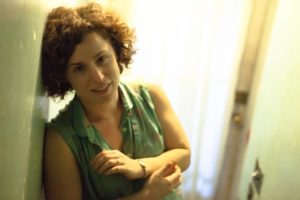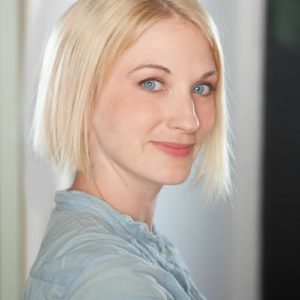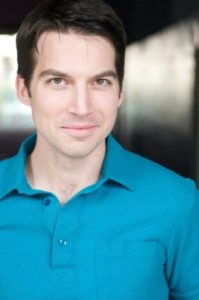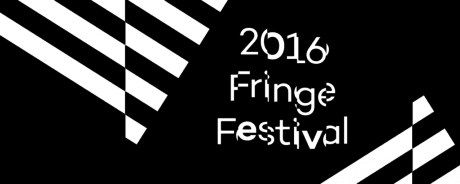Applied Mechanics (AM) is a Philadelphia-based collaborative ensemble that has been making original, immersive theater since it was founded by Director Rebecca (Becky) Wright and Designer Maria Shaplin in 2009. Inspired by dioramas, theme parties, choose-your-own adventure books, zines, feminism, collectivity, and social justice movements, Applied Mechanics has become a standing ensemble of five artists who jointly created eight original works so far—winning a cult following in the process.
As part of an exercise in civic engagement and transformation, AM asks performers and audiences to share space, and move around freely—whether audience members rummage through a character’s suitcase, eavesdrop on a conversation, or read the writing on the wall, no two people see an AM show the same way.
Applied Mechanics consists of five devisers—creative people who work with a form of theater where the script originates not from a single writer but a collaborative, improvisatory group of people—Rebecca Wright (director/creator); Maria Shaplin (production designer/creator); Thomas Choinacky and Mary Tuomanen (performers/creators), and Jessica Hurley (dramaturg/creator). For FEED, they are joined by guest performer-creator Brett Robinson.
Philadelphia Fringe audiences will “explore the fields where we grow crops and the tables where we break bread. Seeds are time capsules, recipes are histories, and food unlocks rituals for communing with the dead.” The company, well-known for both challenging and nurturing its audiences, added a better invitation to their latest show than any restaurant in the city with the broken bell: “Bring your appetites: this is a play you can eat.”
How do you explain the concept of Applied Mechanics to a new or a traditional theater-going friend?

Becky: We make plays that take up huge rooms or large buildings, plays that you can walk through—instead of just sitting down and watching. There are many scenes unfolding simultaneously and you get to choose what to watch and the angle you want to watch it from.

Mary: Good for voyeurs, videogamers, and vallflowers [sic].
What have been your best AM experiences so far?

Thomas: All the food. Becky is an amazing cook. In the early years of AM she did all the cooking. Now the rest of us are sometimes her sous chefs. It is the nourishment and community that was created over sharing a meal at every rehearsal that transformed so much about us—both as individuals and as a company.

Brett: We had a weeklong residency at the Celebration Barn Theater in South Paris, Maine. It was an incredible time—not only to generate material, but to get to know my collaborators in a way that I wouldn’t have been able to in a more traditional rehearsal process. We spent a lot of time talking about the piece outside of rehearsal time. So I had the opportunity to learn how people thought about the world we were creating and the work in a more casual setting.
How has the Applied Mechanics’ culture impacted your way of seeing theater arts in our own time?
Thomas: Since each member of Applied Mechanics comes from different backgrounds and training methods, I have been constantly provoked, supported, and challenged by my fellow theater artists with whom I collaborate. It is this push/pull sharing and collaboration that brings me to the theater. Performances that treat their work as seeking invention are very provocative to me, especially as they ask big questions and require imagination—unlike anything in theater before.
I’ve become aware of a necessary need for questioning how and why a performance is made in this current time and moment. A couple of years ago, I was a Barrymore nominator. I saw many works that were only having a conversation with themselves. Happily, theater is being broadened by experimental performance locally and nationally. This includes the types of performance that break the traditional theater rules of placing audiences to sit in a dark room for a couple of hours. However, we are slowly transforming the next generation of art-making, which includes interdisciplinary, participatory, and rule-breaking theater.

Maria: Sometimes it makes me wonder why people keep producing the same plays over and over again. I would always rather make and/or see something new. The art that is responding to what is happening right now in the world activates my brain in a way that a Shakespeare play can’t. Even modern productions of Shakespeare plays make me feel like I’m being forced to go out to lunch with my Grandmother at her favorite tea house. It’s boring. Nothing is spicy, nothing is fresh, the decoration is old and dusty, and it makes me want to play with my phone under the table.
Maria, as vivid and entertaining as this scenario sounds, you took an unusually strong stand vis-a-vis contemporary Shakespeare productions. As a result, some people will love you while others will probably go berserk and disinherit you.
Maria: I design Shakespeare quite a bit, so I feel entitled to that opinion. My comments probably won’t stop [Shakespeare] directors from asking me to design for them, and won’t stop me from designing for them, or even from going to see their productions. However, if artists allow public opinion to effect our work or self-image—well, that’s a slippery slope to self-destruction. I’m well-armed. Bring on the strong responses!
What were some personal stumbling blocks for you when you first started working with AM?
Brett: When I first came on board, I was nervous about fitting in with such a tight-knit ensemble. It made me a little shy and a little hesitant to share my thoughts. But Applied Mechanics is generous in a way that really allows creativity to flourish and makes you feel a part of their community. It comes through in the work as well. You can’t make work that gives such freedom to the actors and the audience without that kind of generosity.
Thomas: The meetings were—and still are—long and exhausting. But what I realized is that this is the effort required to participate in democratic decision-making. Each member has an equal say in what gets accomplished. Based on the joint decisions by the company, we have built a collective that attentively practices what we believe. That doesn’t mean that decision making is easier, but it is equal, shared, and cooperative.
Becky: Whenever you’re doing something formally experimental, there are lots of stumbling blocks. Your aesthetic—and all its politics and eccentricities—are not just in the content of the piece, but in the shape and structure of the art work. The whole form must be questioned and carefully considered. There’s no road map.
You work hard to create a radical new piece, and something in you just wants everyone to love it—but many theater-goers prefer a regular play in a theater that they can sit down and watch. Our work has a particular, beautiful, enthusiastic audience, but I’ll admit that it used to be a stumbling block for me that it’s just not everyone’s thing.
What do you consider one of your most important contributions to the AM experience?
Maria: Applied Mechanics is where I get to flex all my scenography muscles. I’m in charge of conceiving and materializing the physical worlds of our plays. My designs for this company are the most clear and uncompromised versions of my personal aesthetic that I make in a season.
Mary: Applied Mechanics is where we can play out our most outrageous ideas. My bizarre obsession with Napoleon Bonaparte became a late-night drunken voicemail of three of us to Becky, which then became a sort of dare as we conceived a performance that would show the entire Napoleonic era in one hour with a cast of 26. And then we did it. Twice. My job in Applied Mechanics is to think big and think weird. The Inquirer has called us “Philadelphia’s most unusual theatre company,” and we have to live up to that name.
How did the AM collective get into food and what expertise do you bring to this subject?
Becky: When we first started making work, we couldn’t really afford to pay anyone. However, we promised dinner—with food groups—at every rehearsal. Sharing a meal during rehearsals became a central part of our process. Even as our budgets grew and we began paying ourselves and our collaborators real fees, we have maintained the practice.
A few years ago, as part of an effort to expand this practice to include a broader community, we started offering bi-annual community dinners at Philadelphia’s Christ Church Neighborhood House. These are big, free meals that anyone can come to. We cook for about 100 and ask people to bring their own bowls. Breaking bread together is a fundamental community-building practice. We find that it feeds the work in profound and direct ways—it’s ensemble building, but beyond that, it’s also culture building, and that culture becomes part of the worlds we create in our plays.
It’s exciting to be doing that in a more direct way with FEED, and to challenge ourselves with making this company practice central to the artistic conceit of a piece. None of us are food experts or professional chefs, but there’s a real aesthetic to home cooking, and that aesthetic is related to the domestic space—a traditionally underrepresented, undervalued, and feminine space.
Part of the impulse to make plays where the characters never exit and where their mundane tasks are represented alongside their remarkable actions is a specifically feminist impulse—one that’s about bringing background stories into the foreground and celebrating daily labor, including domestic labor, traditionally cast as “women’s work.” Food is very much a part of this impulse, as are other kinds of home-made-ness.
All that said, our process is quite research-driven in its early stages, and we’ve done a ton of research on foodways, food production, and the politics of food in preparation for this piece. Food is very personal, and for many people, their relationships with it are tied up with all sorts of traditions and nostalgias. To make FEED, it’s been important to push beyond ourselves and our own attachments to certain kinds of food and eating habits.
The US is probably the world’s worst offender of food abuse, both in terms of eating the wrong foods in unhealthy proportions and in throwing away more food than anywhere else in the world. As a result of your work with AM, how have you changed some of your dietary behaviors?
Mary: In this particular project, we had Dr. Cain Elliott of the Critical Writing Center in the School of Arts and Sciences at the University of Pennsylvania come speak to us as an expert on Human Extinction. He had a very utilitarian view of eating in terms of how to minimize your carbon footprint through alternative diets, most notably by consuming lab-made meal replacement drinks like Soylent [a drink “engineered to provide all the protein, carbohydrates, lipids, and micronutrients that a body needs to thrive”]. This perspective certainly impacted my view of food consumption.
Fans of Soylent Green [the 1973 American science fiction thriller film], don’t worry! The folks who created this product had a dark sense of humor, naming their food after a movie about humans consuming humans—but it’s made of soy, not people. Spoiler: Soylent has now made it into our Fringe show as something for the audience to try.
Brett: I have become more aware of my own eating habits and have started eating two vegetarian meals a day. It’s not a huge challenge, mostly due to Becky being an amazing cook. I don’t feel like I have compromised much. It’s a great feeling to see a problem in the world and to take steps to make changes in your own life.
Thomas: Originally, becoming vegetarian as a part of the project was an artistic provocation for me. However, our research—which has included the expected concerns around environmental issues, animal ethics, etc.— have been installed into my life not just as a provocation, but a lifestyle change.
Maria: This project has made me fall into a new, deep love affair with growing, cooking, eating, and reading about food. I enjoy every stage of the process. Right now, I am growing vegetables for use and display in the show. I just started a mushroom spawn today. My partner has been reaping the benefits of the extra care and attention I put into my cooking and food prep.
I feared that this project might sour me to factory farming; especially industrial animal farming. Instead, my research has revealed that food production systems in the US are not patently evil, but flawed in complicated ways. Now I am deeply critical of monoculture farming practices. There is a lot of waste built into how we grow, distribute, and consume food. It’s bad for the land, and it’s not sustainable for the farmer or the economy. As a result, I definitely do look into my trash can—and have feelings.
How are AM group members “experimenting with time and how differences in location, accessibility, globalization, etc. have affected the way people eat”?
Becky: Food is truly central to human life and exists, fascinatingly, at the nexus of the domestic and the global. The three characters in FEED are from three different time periods, separated by a hundred years or more. They all inhabit the same geographical location, but time affects the way the characters think about, acquire, and prepare food. Audience members will literally get to taste the differences wrought by time, because each of the characters will be serving their specific food to the audience.
As for FEED, our early research on the piece opened up a vast network of interconnected, food-pertinent topics—from environmental change to human evolution to contemporary farming practices, traditional foodways, the history of the spice trade, and the science of seed vaults, etc. We’re doing experiments with time in lots of different ways. We’re actually conceiving of FEED as one part of a trilogy, each part of which will depict multiple, coexistent time periods as a way of dramatizing and exploring historical resonance. Last fall, at the University of the Arts [in Philadelphia], we did a workshop of another part of the trilogy, which juxtaposed three different American protests and uprisings. We will premiere the third part in the spring of 2018.
What distinguishes AM from many other theater groups, and what gives you the conviction that you can make your “work accessible to all people, and actively reach out to a wide breadth of communities and a diverse set of people—not just the everyday theater-goer,” even going beyond a few Fringe performances, here and elsewhere?
Mary: This inclusiveness really peaked for us with We Are Bandits, our 2014 show. We wanted to make a piece of art that also felt like an effective protest where anybody could come to the community center for free. This audience brought together a jumble of different viewpoints, especially as the show is queer-positive, woman-positive, widely inclusive, and loving—and addressed a broad range of issues.
We advertised We Are Bandits in the street by singing songs from the show, costumed in plastic skirts with feminist slogans and pictures on them. Young folks were learning the songs and singing along. Older women were coming over and chatting about their favorite feminist heroes. Then, when those people came to our shows, they had an experience that put them in the center of an imagined landscape that they could walk through, become a part of, and be galvanized.
In a protest, you take power just by showing up. We put our audiences at the center and hope to empower them, so that they could say, “This happened, and I was a part of it.”
That experience travels with every Applied Mechanics show. For example, when we go to Washington College, MD this February, or wherever else we end up taking FEED, we’ll bring this spirit with us. It’s the sort of life-force we need to carry forward if we want this art form, this culture, this species, to survive.
Listening to all of you, my stomach is rumbling: Yes to FEED. Yes to AM at any time—day or night.
Feed plays September 7- September 19, 2016 at the 2016 Fringe Festival performing at Painted Bride Art Center—230 Vine Street, in Philadelphia, PA. For tickets, call the Fringe Arts box office at (215) 413-1318, or purchase them online.






